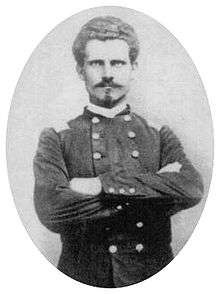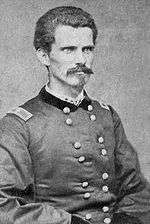Robert Francis Catterson
Robert Francis Catterson (March 22, 1835 – March 30, 1914) was an American physician and soldier. He served in the Union Army during the American Civil War, enlisting at its beginning and rising to a general officer near the end. After the war, Catterson worked in the cotton market, law enforcement, politics, and farming.
Robert Francis Catterson | |
|---|---|
 Robert Francis Catterson | |
| Born | March 22, 1835 Beech Grove, Indiana |
| Died | March 30, 1914 (aged 79) San Antonio, Texas |
| Place of burial | San Antonio National Cemetery, San Antonio, Texas |
| Allegiance | United States of America Union |
| Service/ | United States Army Union Army |
| Years of service | 1861–1866 |
| Rank | |
| Battles/wars | American Civil War |
Early life
Catterson was born in 1835 on a farm near Beech Grove in Marion County, Indiana. He was the son of an Irish immigrant, but his father died in 1840 when Robert was only five years old. Catterson's education began at Adrian College in Michigan, and then he attended Cincinnati Medical College in Ohio, precursor to the University of Cincinnati Academic Health Center. After completing his medical studies, Catterson established a medical practice in Rockville, Indiana, just prior to the start of the American Civil War.[1]
Civil War service
When the American Civil War began in 1861, Catterson chose to follow the Union cause. He gave up his medical practice and volunteered to serve in the Union Army, enlisting in the 14th Indiana Infantry Regiment.[1] On April 23 Catterson was mustered in as a private into Company A of the 14th, and on June 7 was promoted to first sergeant. Catterson was then elected as an officer, and he was commissioned a second lieutenant on July 5. The following year he was promoted to first lieutenant on March 15, 1862.[2]
In 1862 Catterson saw his first battle during the Valley Campaign, participating in the First Battle of Kernstown on March 23,[3] and was promoted to captain on May 4.[2] Catterson next fought during the Maryland Campaign and the Battle of Antietam on September 17, where he was wounded.[4] Upon recovering, Catterson was appointed lieutenant colonel in the 97th Regiment Indiana Infantry on October 18, and its commander as colonel on November 25.[2] Catterson and the 97th Indiana served the Battle of Memphis in Tennessee on June 6, 1862, and the subsequent occupation of the city, until late in 1862. He then took part in the Siege of Vicksburg in the spring of 1863 and the Tullahoma Campaign that summer. Catterson and his command participated in the Third Battle of Chattanooga on November 23–25, and the Atlanta Campaign throughout the summer of 1864.[5]

During Maj. Gen. William T. Sherman's March to the Sea in the winter of 1864, Catterson was part of the Army of the Tennessee, heading a brigade in its XV Corps beginning on November 22, 1864.[6] He fought in the Carolinas Campaign of 1865, participating in the Battle of Bentonville in North Carolina on March 19–21, the fight considered the last major engagement of the American Civil War.[7] Also during the Carolinas Campaign, Catterson served very briefly as chief of staff to Maj. Gen. John A. Logan, the commander of the XV Corps.[8] He then returned to his brigade, leading it for the rest of the campaign and to the end of the war. Catterson was brevetted to brigadier general in the Union Army on May 31, 1865, and was mustered out of the volunteer service on January 15, 1866.[5]
Postbellum
After the war, Catterson chose not to return to practicing medicine; he moved to Arkansas, where he tried and failed at cotton speculation.[3] He then became commander of the Arkansas Negro militia under Governor Powell Clayton, engaged in fighting against the Ku Klux Klan members operating there,[5] and also as a United States Marshal. During Clayton's successful political run for the U.S. Senate, Catterson was removed as marshal when he lost the favor of Clayton, and replaced by Isaac Mills.[9] He would later command the Brooks forces, during the Brooks–Baxter War.
Catterson was the mayor of Little Rock, Arkansas, from 1872 to 1874. After serving as mayor, he moved to Minnesota, where he was unsuccessful as both a farmer and a farm implement merchant. He died at the age of 79 at the Veterans' Hospital in San Antonio, Texas, after suffering from a stroke.[5] Catterson was buried in the San Antonio National Cemetery at Section A, Grave 176/177.[7]
Notes
- Warner, p. 75.
- Eicher, p. 168.
- Warner, p. 76.
- Eicher, p. 168. Wounded "in right knee, left hand, left foot, and right buttock, Antietam, Md., 17 September 1862"
- "Robert Francis Catterson". Civil War Indiana Biographies. Archived from the original on May 12, 2008. Retrieved November 22, 2008.
- Eicher, p. 168. Lead the 2nd Brigade, 1st Division, of the Union XV Corps.
- "Robert Francis Catterson". Find A Grave. Retrieved November 16, 2008.
- Eicher, p. 168. Was chief of staff, Union XV Corps, from March 28 to April 4, 1865.
- Warner, p. 76. "But he later fell out with Clayton during the latter's successful campaign for the U.S. Senate, and as a result lost his position of United States marshal."
References
- Eicher, John H.; David J. Eicher (2001). Civil War High Commands. Stanford University Press. ISBN 0-8047-3641-3.
- Warner, Ezra J. (1964). Generals in Blue: The Lives of the Union Commanders. Louisiana State University Press. ISBN 0-8071-0822-7.